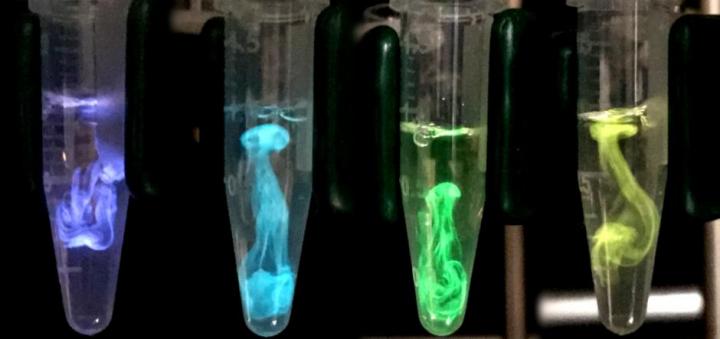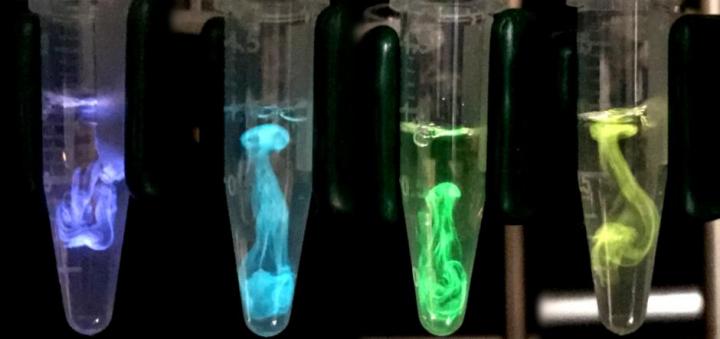
Credit: Nathan Shaner
PROVIDENCE, R.I. [Brown University] — With up to $9.2 million in funding over five years from the National Science Foundation, Brown University will lead a national center dedicated to developing and disseminating new tools based on giving nervous system cells the ability to make and respond to light. Neuroscientists could use the tools to uniquely manipulate and observe the circuitry of the brain in a variety of model organisms.
The new "NeuroNex Technology Hub" is a collaboration of labs at Brown, Central Michigan University and the Scintillon Institute. The team's charge is to invent, improve upon and combine several unique bioengineering technologies to create new research capabilities. They will then make their advances rapidly, easily and freely available to the global scientific community.
"Through NeuroNex, we want to enable all scientists to take advantage of the best tools," said principal investigator Christopher Moore, a professor of neuroscience at Brown and associate director of the Brown Institute for Brain Science (BIBS). "There is a real problem in science of certain inequities in access. The idea is to systemically address that."
The center's other leaders are Diane Lipscombe, a Brown professor of neuroscience and BIBS director, Ute Hochgeschwender, a professor at CMU, and Scintillon researcher Nathan Shaner. Justine Allen, a graduate of Brown's doctoral program in neuroscience, will serve as the center's administrative director.
In addition to creating the new tools for the scientific community, the team intends to turn its research, which combines elements of biology, chemistry, physics and engineering, into a curriculum to engage and educate high school students.
Enlightened brains
The research has its roots in bioluminescence, the natural ability of cells to make light, as fireflies and many aquatic animals do. Moore, Lipscombe, Hochgeschwender and Shaner have already been working together to engineer bioluminescence into a variety of cells, including neurons, in a project supported in its early stages by the W. M. Keck Foundation. Their work includes making light production contingent on an influx of calcium, a typical means that neurons employ to trigger each other into action. They've also created a brighter form of bioluminescence with proteins they call LumiCaMPsins. In the new project, they will continue to work to create even brighter calcium-modulated bioluminescence in neurons.
The team combines this engineered bioluminescence with optogenetics, a decade-old technology in which distinct types of neurons can be genetically altered to turn on and off in response to light. Currently, optogenetics requires scientists to inject light into the brain of an animal via fiber optics at times and places they hope are appropriate for their work. But when bioluminescence and optogenetics are combined (the scientists call this "BL-OG"), cells can illuminate and regulate themselves when an event, such as a particular behavior, spawns an uptick in calcium. Cells programmed in this way, Moore said, can automatically respond to experimental conditions without the scientists having to manually stimulate them.
As a hypothetical example of how meaningful that could be, Moore posits a clinical application of the technology (should it become applicable in humans in the future). Imagine that a person with epilepsy is about to have a seizure, he says. As neurons with BL-OG begin to become overly activated by surging calcium levels, they could emit light that would optogenetically override that hyperactivity, automatically dampening out the seizure before it can get started.
Beyond programming cells to regulate their own activity, the team also hopes to develop ways to make cells stimulate each other with light. Such "inter-luminescence" would allow scientists to program and observe calcium-modulated dynamics in whole circuits, Moore said.
Moreover, the group also plans to create new imaging tools. Using a variety of fluorescent molecules, including some that Shaner helped to pioneer, scientists today can make cells glow in response to experimental events, Moore said, but that requires shining a stimulating light on them that can damage tissue and adds a source of noise as that incoming light scatters. Bioluminescence allows cells to glow on cue without that external stimulation, reducing the possibility of damage and reducing a source of scatter. Implanted imaging devices could also be lighter and use less power if they don't have to produce stimulating light.
Moore said one of the reasons the collaborators are excited to share what they are finding is that there is much more room for innovation with the technology than they can fill on their own.
"In our own experience as a cloud of labs working on this stuff, the list of things we want to create to make the world better is getting bigger and bigger," Moore said. "We want to enable the whole field to let them all go after it."
Enlightening minds
As they develop new tools and techniques, the team will employ several means to disseminate them, Moore said. They will produce a website with downloadable experimental protocols, genetic sequences and other documentation and will send "emissaries" to teach other research groups. They will annual hold workshops for visiting scientists to come together, generate and discuss ideas, form new collaborations and learn how to use the new technologies.
"Bring all your students and all your postdocs, and inspire them to take a few of these research questions," Allen said. "Take those home and let this grow."
Moore noted that the collaborators have a strong ethic of such openness. He serves on the board of OpenEphys, an open-source initiative to promote sharing of electrophysiology tools started by two former graduate students in his lab. Lipscombe, Hochgeschwender and Shaner have also openly shared tools and technologies with the research community before, he said.
In addition to teaching other scientists, Moore said, the collaboration will also teach students at several different levels. They plan to hold a weeklong "intensive practicum" course for undergraduate students every spring at the Marine Biological Laboratory in Woods Hole, Mass., to which they encourage applications from students underrepresented in science, technology, engineering and mathematics. They will also create and teach courses in local Providence high schools that already work with the Brown Brain Bee. And finally, Moore said they hope to create an online version of the curriculum for other schools nationwide.
The grant (1707352) formally begins Aug. 1.
###
Media Contact
David Orenstein
[email protected]
401-863-1862
@brownuniversity
http://news.brown.edu/
Original Source
http://news.brown.edu/articles/2017/08/bioluminescence





